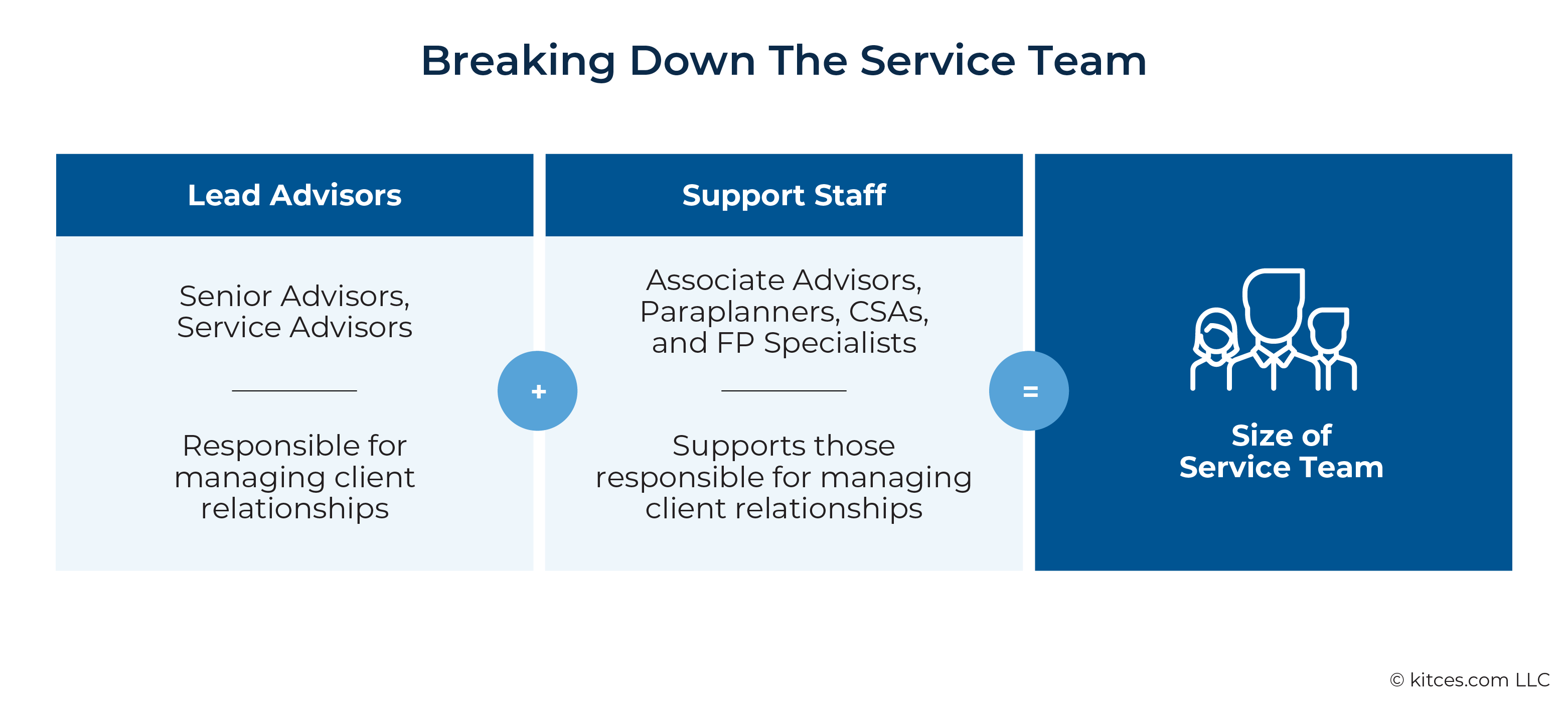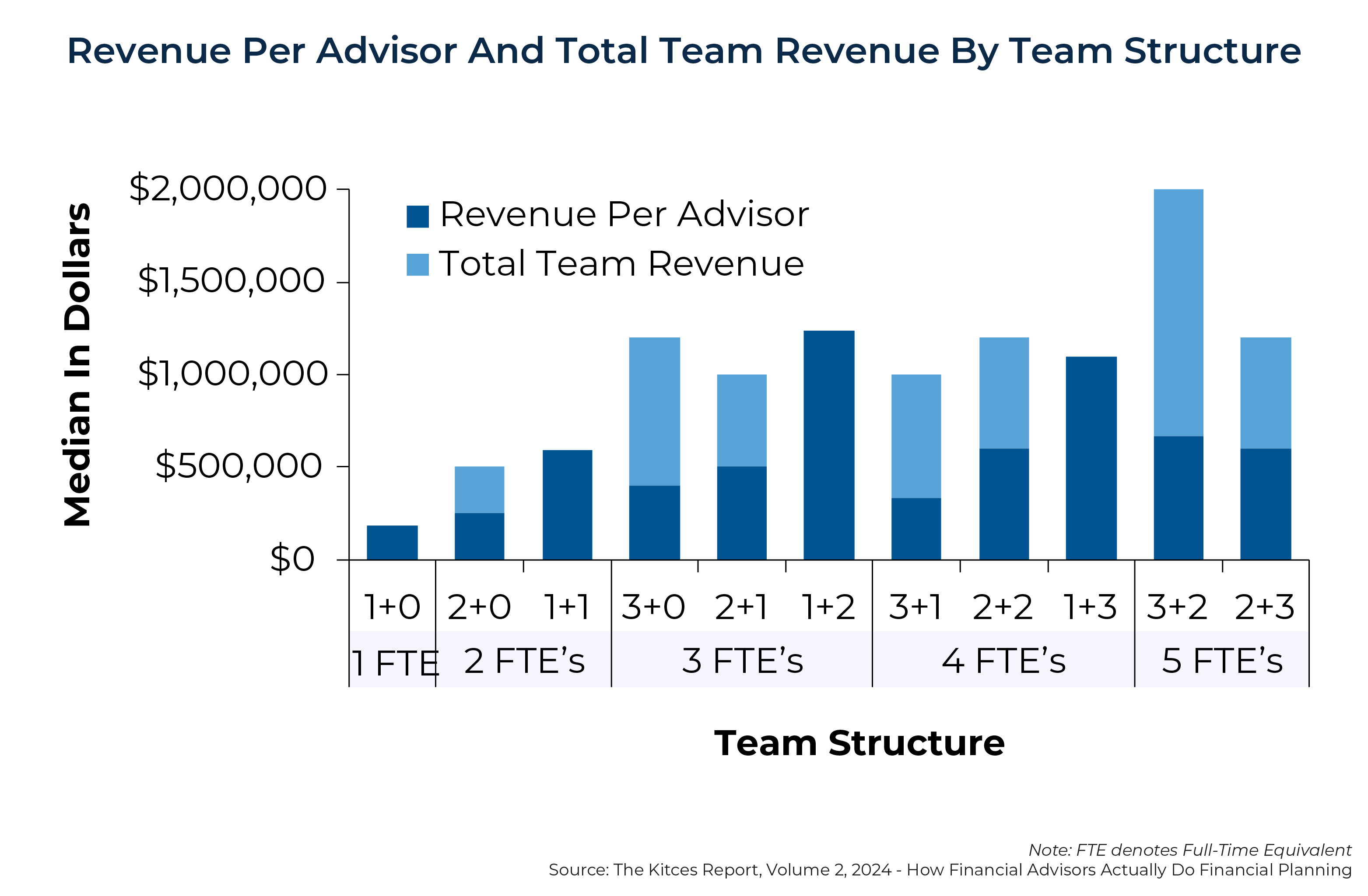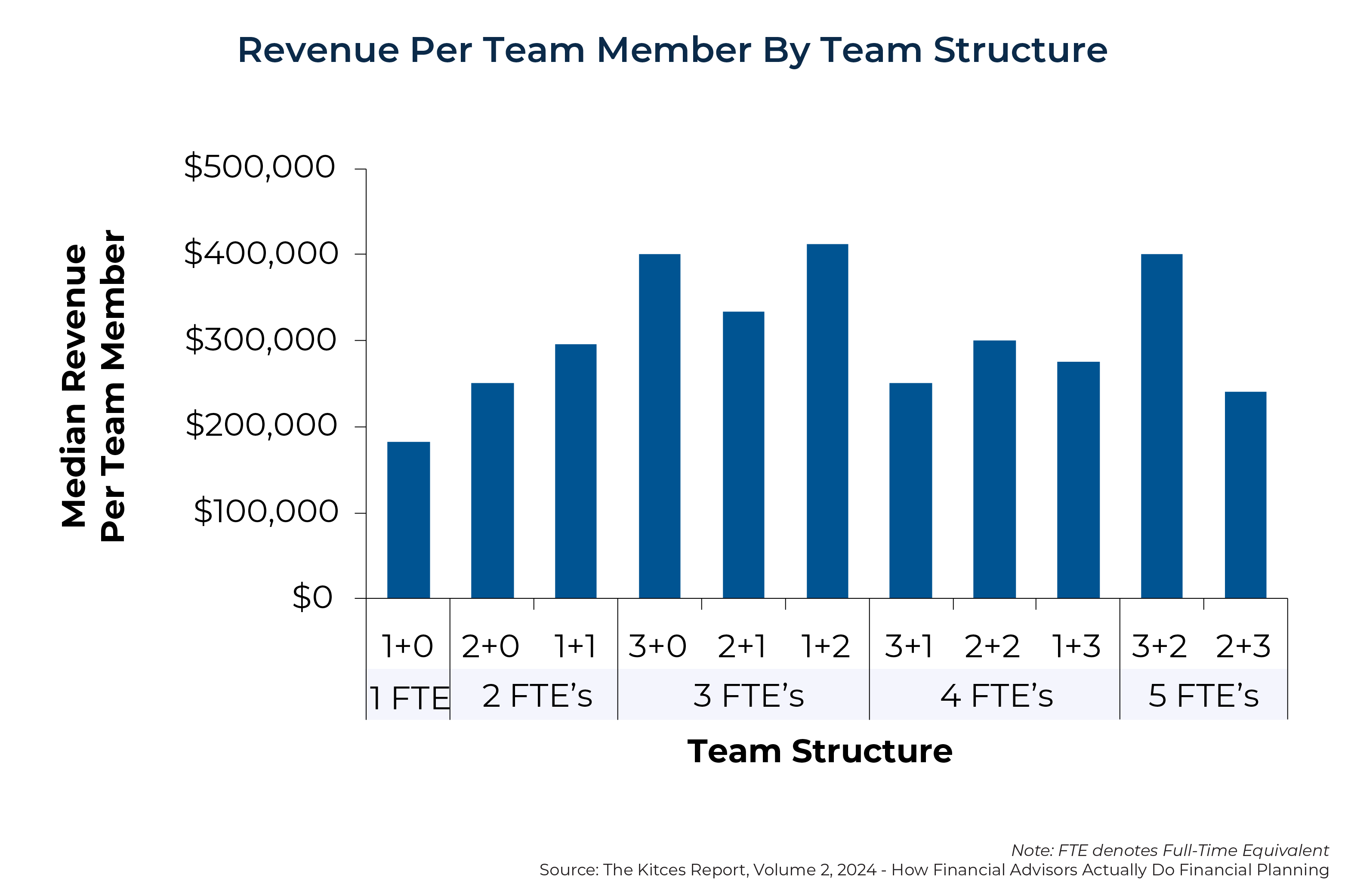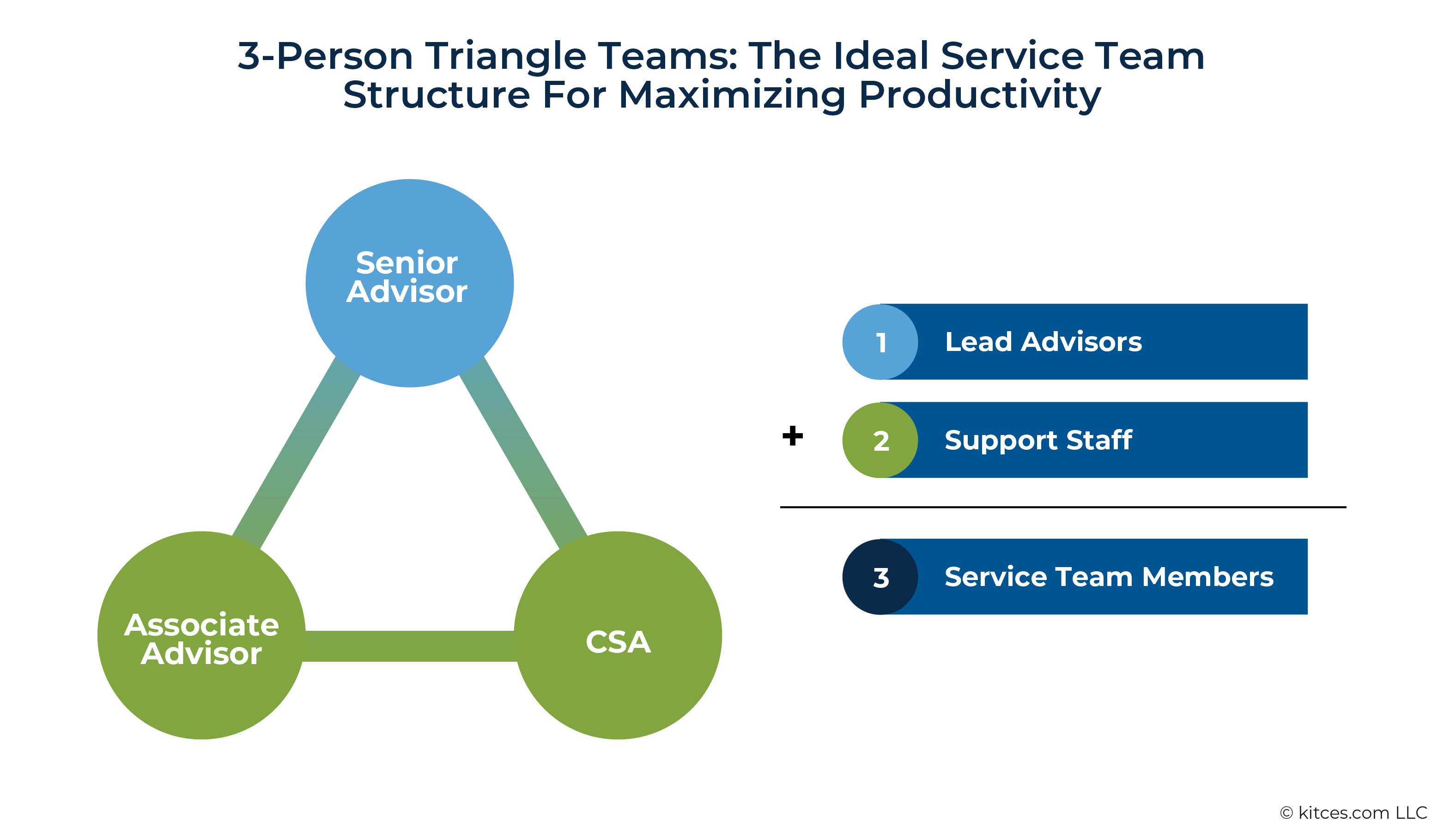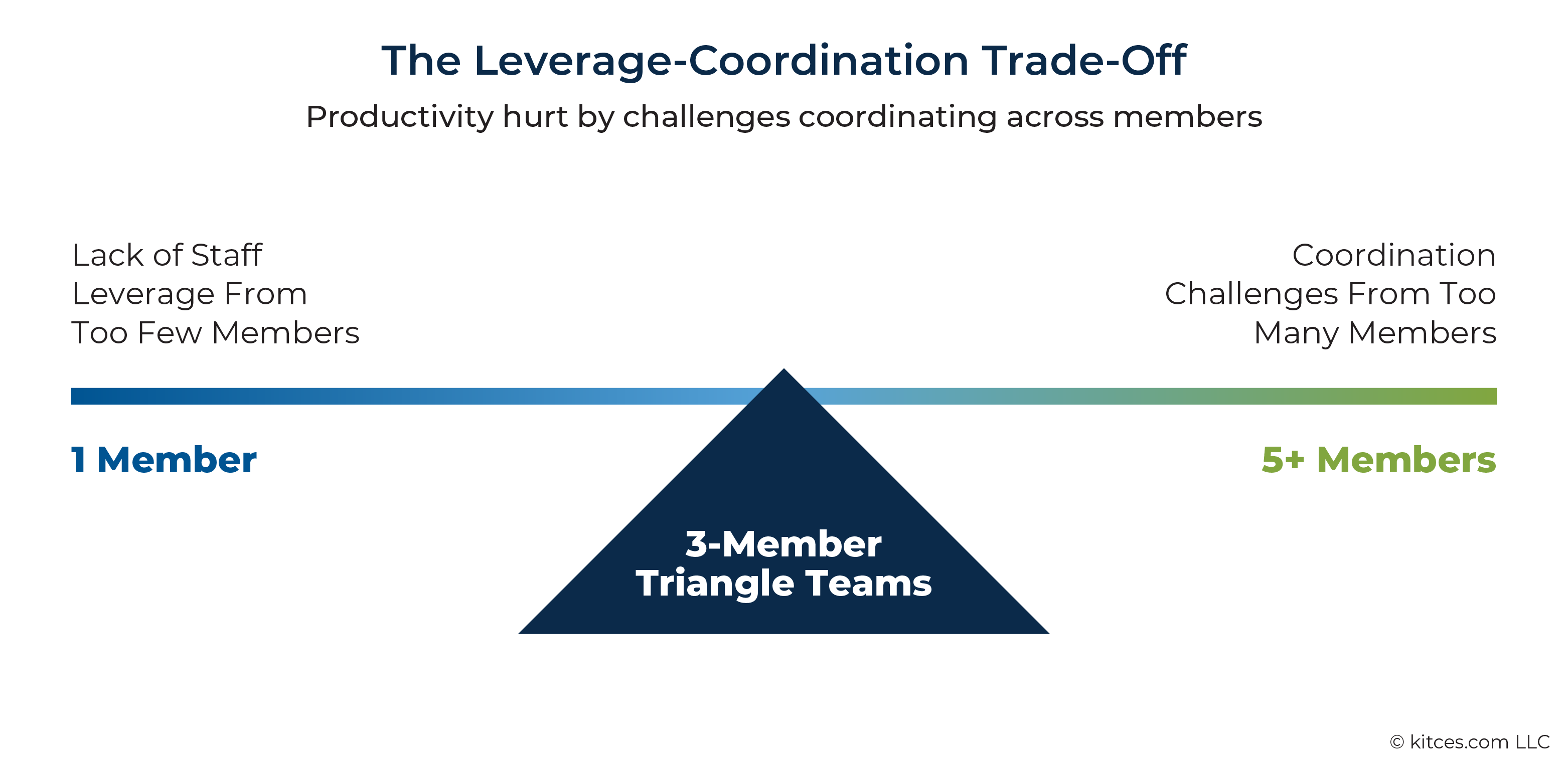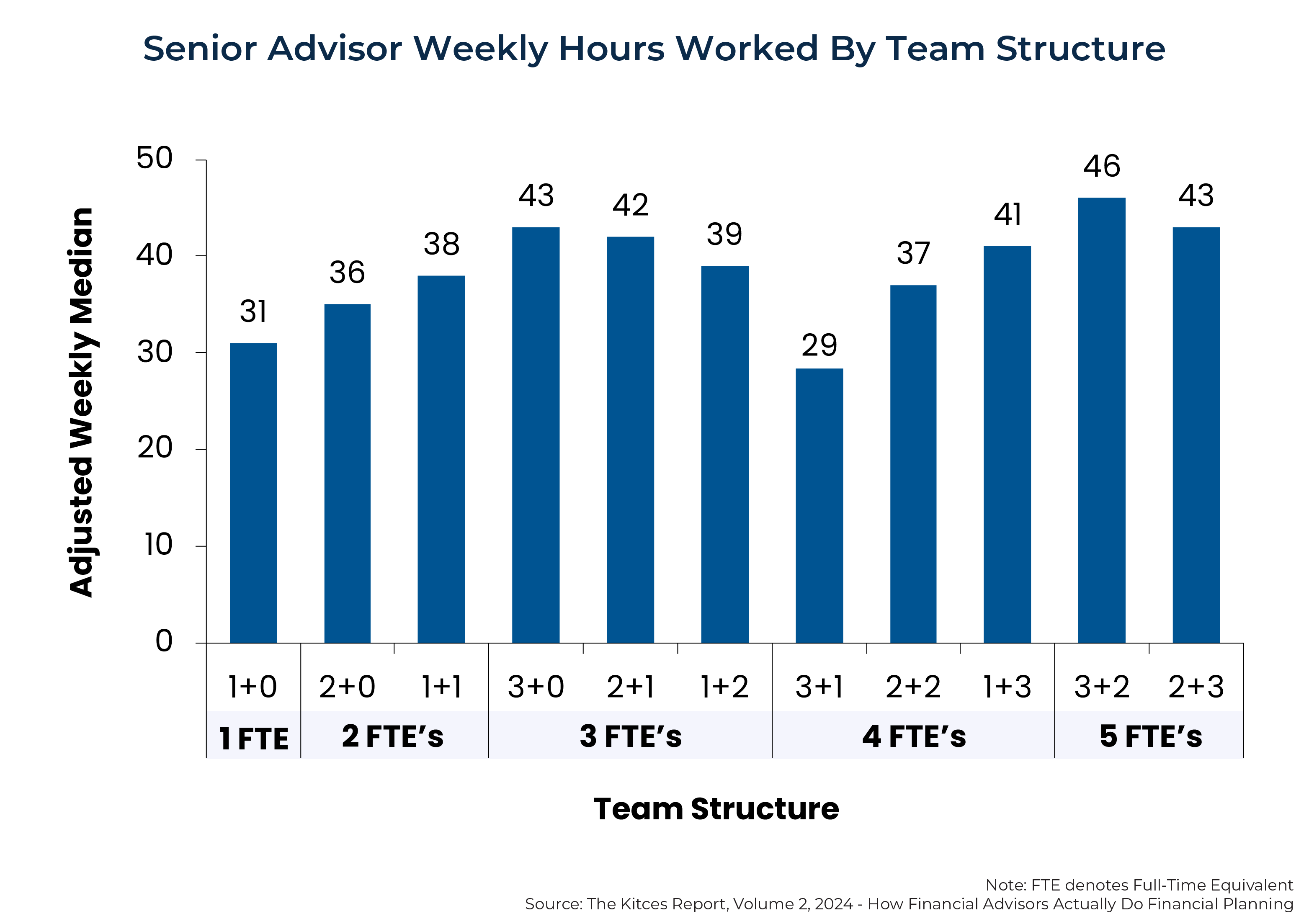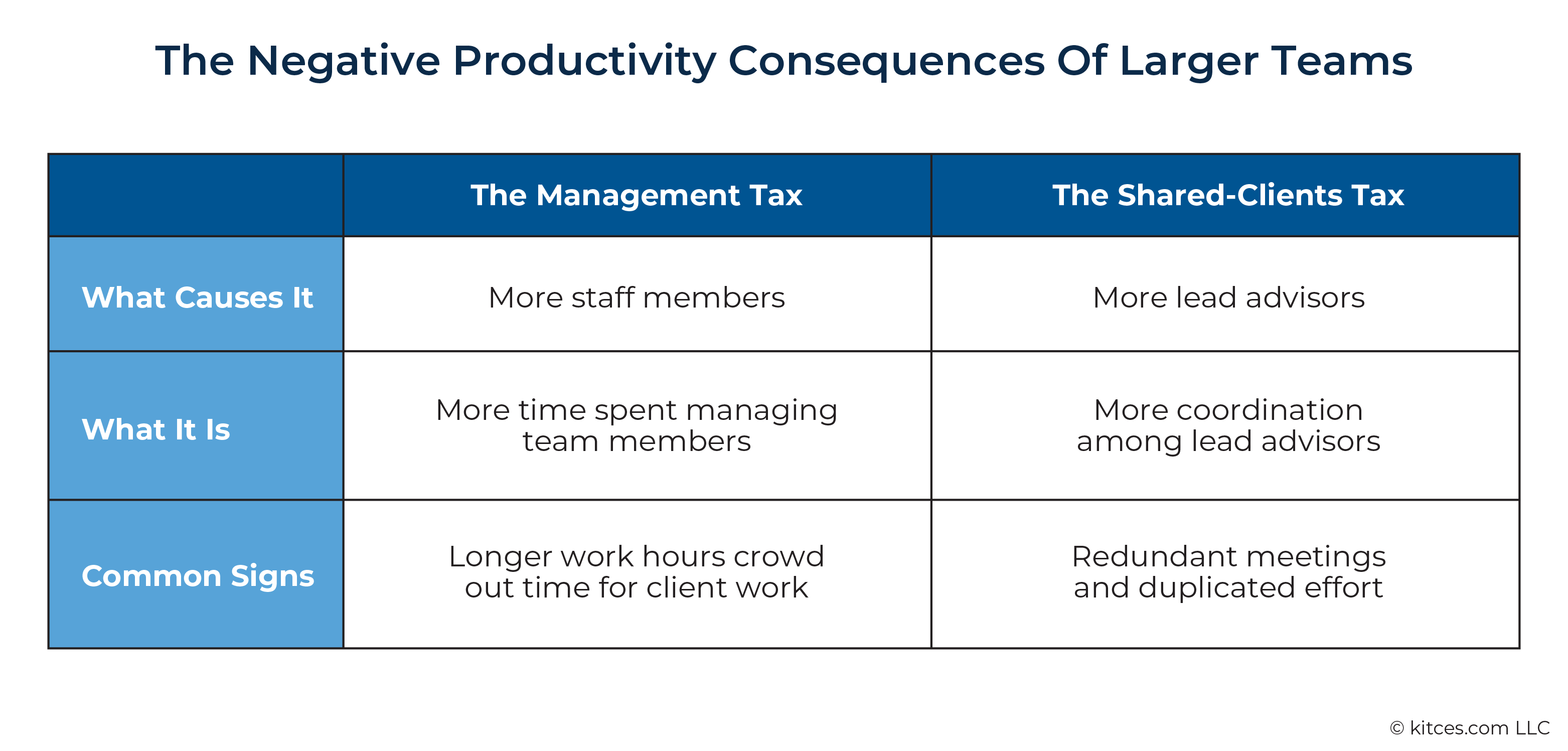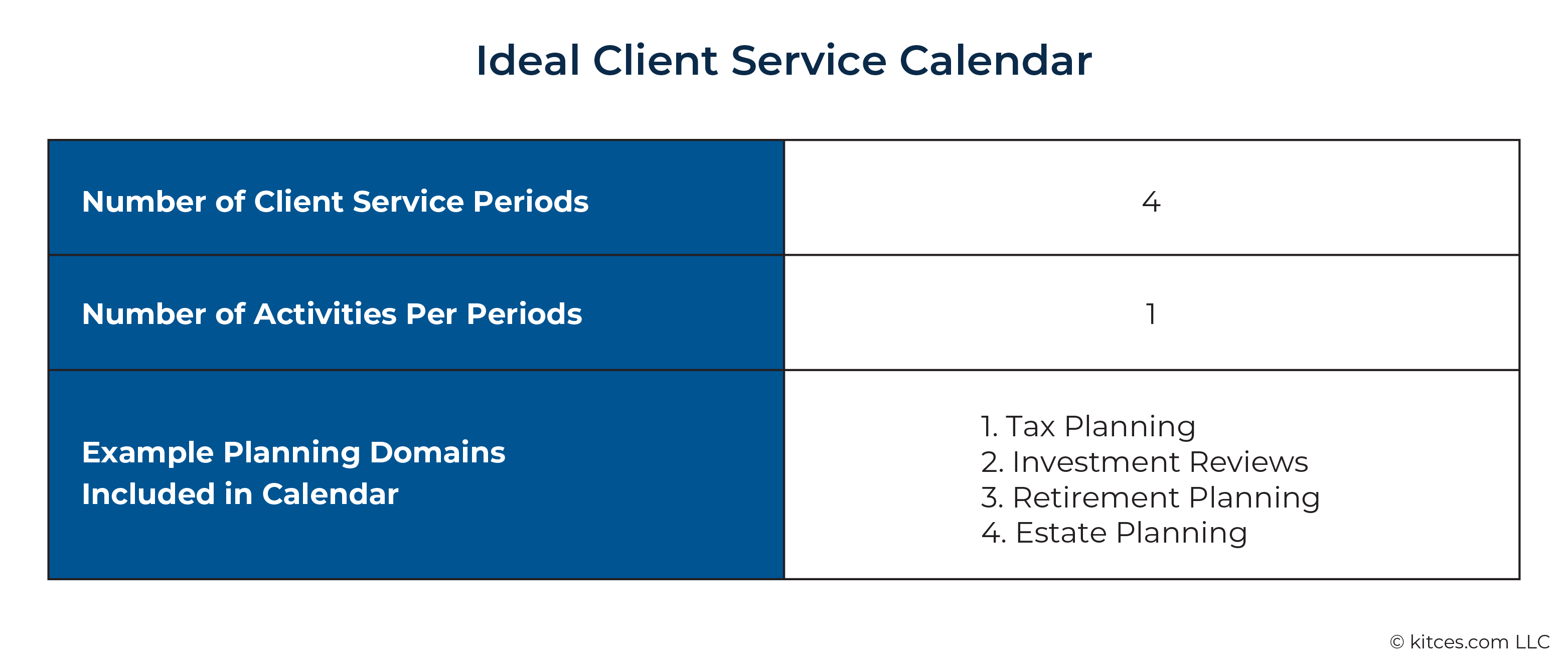Executive Summary
The smallest advisory firms – especially those run by unsupported solo advisors – often find that early success brings growing operational demands that strain their time, energy, and wellbeing. Yet after adding team members to grow their firms, many advisors discover that their capacity challenges are replaced by new inefficiencies stemming from the need to coordinate across multiple people, leaving them without the calendar control they had hoped to gain.
In this article, Mark Tenenbaum, Kitces.com's Director of Advisor Research, explores findings from the latest Kitces Research study on advisor productivity, "How Financial Planners Actually Do Financial Planning". The research highlights that the three-member "Triangle Team" – consisting of one lead advisor and two support staff, typically a Client Service Associate and an Associate Advisor – tends to be the most effective team structure for maximizing productivity. The typical Triangle Teams produce an impressive $1.2 million in average revenue per advisor and $412,000 per employee, outperforming all other team configurations, which adds Service Advisors but results in lower productivity per advisor and per employee.
The success of Triangle Teams lies in their ability to balance what Kitces Research describes as the "leverage-coordination trade-off". Smaller teams consisting of one or two members inherently avoid the coordination challenges that increase with team size, but they often lack the staffing leverage needed to free up the Senior Advisor to focus on business development. By contrast, larger teams provide advisors with this leverage, but their additional seats often fail to translate into productivity gains because they introduce two key inefficiencies relating to coordinating across too many members: the "Management Tax" and the "Shared-Clients Tax".
These two inefficiencies take shape in distinct but compounding ways. The Management Tax occurs when Senior Advisors must spend more time onboarding, training, and managing staff – time that doesn't scale with team size. The Shared-Clients Tax arises when multiple lead advisors serve the same clients, requiring additional meetings, handoffs, and coordination that detract from client-facing work. Triangle Teams strike the optimal balance: Two support staff provide enough leverage to offload lower-value tasks while staying lean enough to avoid excessive coordination demands.
For solo or two-member practices, moving toward a 1+2 Triangle Team structure can be a strategic path to growth. Hiring a CSA first, followed by an Associate Advisor, can significantly boost productivity – if timed between the "profitability wall" (when hiring becomes financially viable) and the "capacity wall" (when help becomes urgently necessary). Proactive planning and structured onboarding – especially for Associate Advisors – are essential for success.
Larger teams that aren't positioned to reduce headcount can still improve efficiency by implementing systematized workflows and quarterly client service calendars. Defined processes ease the delegation burden on Senior Advisors, while quarterly client service calendars help prevent overservicing and clarify responsibilities. According to Kitces Research, teams that use four planning periods per year – each focused on a single planning domain – tend to achieve the best mix of client value and internal efficiency.
Ultimately, while three-member Triangle Teams can be a powerful model for enhancing productivity, each firm has the opportunity to define the team structure that best supports its unique mission and the lives its advisors want to lead. Whether the goal is to scale revenue, create more time for client relationships, or design a business that sustains a fulfilling lifestyle, understanding the trade-offs between leverage, coordination, and growth can help advisors make satisfying decisions with greater clarity and confidence!
For many advisory firms, growth comes with a familiar irony: The very success that struggling new firms worked hard to achieve brings with it a new set of challenges. This dynamic is especially visible in solo practices, where a single advisor is responsible for both serving existing clients and acquiring new ones. Over time, many solo advisors grow their practices from scrappy startups into sustainable businesses, only to eventually hit a capacity wall, where the daily demands of servicing existing clients lead to long hours and leave little time to focus on business development or other priorities.
Even those willing to sacrifice evenings, weekends, and time off to push their practices forward are ultimately limited by the number of hours in a day. It's no surprise, then, that Kitces Research data shows capacity-constrained solo advisors report lower wellbeing than advisors on multi-member teams, making them especially vulnerable to burnout.
While technology can provide some relief – such as using AI-generated meeting notes to streamline post-meeting follow-up or using a TAMP to automate investment management – and outside support (e.g., centralized support teams and external third-party platforms or vendors) can help with semi-frequent needs like estate document preparation and insurance implementation, sustained growth and the ability to acquire new clients eventually requires expanding capacity by adding new seats to the team.
However, some advisors have found that even after expanding their service teams to include additional advisors and support seats, they still lack the control over their calendars they once hoped for. Time no longer spent completing certain client service tasks is soon consumed by delegating work and coordinating across team members. Paperwork, once handled directly for clients, is now replaced with writing onboarding plans and performance reviews. As a result, many advisors are left wondering: "I've grown my team – so why haven't things gotten easier?"

Nerd Note:
Kitces Research defines service teams as the individuals working within an advisory firm who are collectively servicing and delivering planning advice to a shared client base. Shared resources – such as centralized Financial Planning Specialists, an investment or trading team, operations staff, or outsourced support external to the practice – are not considered part of the service team.
These respective challenges are unique to smaller and larger teams – and they help explain why three-person service teams have consistently emerged in our research as a sweet spot for driving advisor productivity, striking an ideal balance between capacity and efficiency. and efficiency.
In the recently released Kitces Research study, "How Financial Planners Actually Do Financial Planning", the relationship between team size and two common productivity metrics – revenue per advisor and revenue per employee – was examined in detail. The findings are striking: Revenue per advisor climbs from $200,000 in unsupported solo practices (with one FTE) to $625,000 in three-person teams, remaining relatively stable beyond that point. Meanwhile, revenue per team member peaks at $357,143 with three team members, before declining as team size increases further. Simply put, while having a multi-member team of any size is preferable to remaining unsupported as a solo advisor, the reality is that teams containing four or more members often face coordination challenges that prevent their additional seats from translating into higher productivity.
Three-Member "Triangle Teams" – With One Lead Advisor And Two Support Staff – Optimize Advisor Productivity
While three-person teams stand out as the most productive overall, it's important to recognize that not all teams of the same size are structured in the same way. For instance, a three-person team could comprise three Senior Advisors, a single Senior Advisor supported by two Client Service Associates (CSAs), or some other configuration.
At the most basic level, the different roles on a service team can be divided into two groups: lead advisors responsible for managing client relationships – e.g., Senior Advisors and Service Advisors – and support staff who assist those responsible for managing client relationships – e.g., Associate Advisors, Paraplanners, and CSAs.
With this framework in mind, the composition of a service team can be described as the number of lead advisors plus the number of support staff. For example, a 3+2 team is a five-person team comprising three lead advisors and two support staff, a 1+1 team is a two-person team comprising one lead advisor and one support staff member (typically a Senior Advisor and a CSA), and a 1+0 team is an unsupported solo advisor.
When comparing both revenue per advisor and revenue per employee across different team structures, the typical 1+2 team in 2023 – comprising one lead advisor and two support staff members, usually a Senior Advisor, Associate Advisor, and CSA – stood out as the most productive team configuration in both metrics. These teams generated a striking $1,237,000 in revenue per advisor and $412,333 in revenue per team member!
(Note: The figure above presents the data differently than most stacked bar charts, where total team revenue corresponds to the topmost point of each bar rather than to the portion of the y-axis spanned by the light blue portion of the bars.)
Teams experience a clear productivity lift when moving from being an unsupported solo advisor (1+0) to making their first support hire (1+1), typically a CSA. As shown in the graphic above, this transition increases average revenue per advisor from $182,500 to $591,000, and, as shown in the graphic below, average revenue per employee increases from $182,500 to $295,000.
Teams get a further productivity lift when expanding to a 1+2 structure by making a second support hire – typically an Associate Advisor – increasing revenue per team member to $1,237,000.
Notably, though, making a third support hire and expanding from a 1+2 to a 1+3 team reduces revenue per advisor by $137,000 to $1,100,000, and revenue per employee by an almost identical amount. Which means that the benefit of the additional support seat is outweighed by the inefficiencies introduced by adding another member.
Teams with multiple lead advisors also consistently underperform 1+2 teams across both productivity measures. This includes 3+2 teams: where three lead advisors are supported by two Associate Advisors, two Client Service Administrators, or one of each. Conventional industry wisdom often cites multiple reasons why this structure is ideal, citing factors such as room for lead advisors to free up capacity for business development or have different specializations. Ultimately, though, Kitces data indicates that 3+2 teams at least on average fail to translate their theoretical advantage into higher revenue per client relationship – whether through premium fees or attracting more affluent clients – in a way that meaningfully improves productivity. Put simply, when it comes to advisor productivity, 1+2 teams – dubbed "Triangle Teams" – outperform the typical 3+2 team.
Perhaps more strikingly, when compared to 1+2 Triangle Teams, other teams with multiple lead advisors often underperform not only in revenue per advisor and revenue per employee, but also in total revenue generation. In theory, firms seeking to maximize aggregate revenue might favor a larger number of (less productive) advisors. Yet in practice, this rarely delivers for teams containing two or three lead advisors. Among these multi-advisor teams, only 3+2 teams exceed the total revenue generated by 1+2 teams.
Taken together, while unsupported solo advisors are decisively the least productive team, the solution to capacity constraints is not to indefinitely add seats to the team. Instead, the data suggests that three-person Triangle Teams – consisting of Senior Advisor, Associate Advisor, and CSA – are the "sweet spot" for maximizing productivity!
The Leverage-Coordination Trade-Off (And Why 1+2 "Triangle Teams" Optimize It)
The observation that three-person Triangled Teams consistently outperform other team structures naturally raises the question of why they are so effective in driving advisor productivity. In brief, their success is rooted in the ability to optimize what can be called the leverage-coordination trade-off.
In essence, the smallest teams (such as one- and two-person structures), almost by definition, avoid challenges related to coordinating across multiple team members. However, they often lack the staff leverage needed to free up Senior Advisors to focus on growing the practice. Larger teams can provide that leverage, enabling Senior Advisors to concentrate more on business development, but introduce inefficiencies of their own related to managing and coordinating multiple members. Triangle Teams optimize this trade-off by providing enough staff leverage from two support members while minimizing the coordination challenges that commonly arise in larger teams.
The First Coordination Challenge Of Larger Teams: The Management Tax
Four- and five-person teams are less productive than three-person Triangle Teams because additional seats introduce two coordination challenges that make it difficult to convert the additional capacity into higher revenue per advisor or employee.
The first of these challenges is called the Management Tax. This tax describes how, when teams grow beyond three members, the administrative overhead required of the Senior Advisor to manage additional employees begins to outweigh the benefits of additional leverage. Each additional seat means another team member who must be onboarded and trained in current workflows. Client Service Associates (CSAs) will have questions about handling inbound client requests, while Associate Advisors may ask for clarification before entering trades or updating client data in planning software. Sprinkled between these routine discussions are questions about benefits, PTO, and opportunities for growth – all of which typically fall on the Senior Advisor.
The weight of this administrative burden helps explain why Senior Advisors on larger teams tend to work more hours than those with fewer members (with the exception of four-person teams). For example, when looking at the weekly median of hours worked (adjusted for time off), unsupported solos average 31 hours per week, compared to 35–38 hours for two-member teams, 39–43 hours for three-member teams, and 43–46 hours for five-member teams.
Notably, expanding from a 1+0 to a 1+1 team (e.g., a Senior Advisor hiring their first CSA) does correspond with an increase of about seven additional work hours per week, while expanding further to a 1+2 team (e.g., hiring an Associate Advisor) adds approximately one additional hour. However, these expansions also correspond with increases in both revenue per employee and revenue per advisor. Continuing to grow beyond this point – such as by hiring a third support member or growing to any five-member team – fails to provide any productivity lift despite the longer work hours required by the Management Tax. (An exception appears to be Senior Advisors on 3+1 and 2+2 teams, who seem to successfully leverage the additional capacity to work fewer hours.)
In sum, while advisors begin to accumulate management duties as soon as their first support hire, these duties are accompanied by increased productivity until the team reaches three members. After that point, the administrative overhead from managing the larger team outweighs the productive benefits of additional staff leverage.
The Second Coordination Challenge Of Larger Teams: The Shared-Clients Tax
The second coordination challenge that often reduces productivity in larger teams is the Shared-Clients Tax.
Many firms adopt a shared-client team structure, where multiple lead advisors serve the same clients, believing this model enhances the client experience and creates the impression of (and capacity for) a higher-touch approach. However, while this approach might theoretically increase revenue per client relationship by helping advisors justify premium fees, it rarely does so in practice. Instead, it often leads to redundant time allocation by lead advisors – such as multiple advisors attending the same meetings – or other inefficiencies, like time spent coordinating responsibilities when servicing shared clients. Ultimately, these factors hinder productivity.
By contrast, teams with a single lead advisor and multiple support staff members inherently avoid these coordination challenges. This dynamic explains why data presented earlier shows that highly leveraged two-, three-, and four-person teams with more support staff tend to be more productive in terms of revenue per advisor compared to those with larger numbers of lead advisors (five-person teams appear to be an exception to this). For example, a 1+3 four-person team is more productive than 2+2 or 3+1 teams.
Exploring The Triangle Team Model As A Path To Greater Productivity
Considering these Kitces Research findings on the relationship between team structure and advisor productivity, 1+2 Triangle Teams appear to be an ideal structure because they optimize the leverage-coordination trade-off. They enable lead advisors to delegate tasks to support staff and spend more time servicing existing clients and acquiring new ones – something unsupported solo advisors, by definition, cannot do – while also avoiding two key inefficiencies that hinder larger teams: the Management Tax (where Senior Advisors spend increasing amounts of time managing team members as their teams grow) and the Shared-Clients Tax (where multiple lead advisors managing the same client base leads to inefficient uses of time, such as ad hoc coordination and having multiple advisors present in meetings). Therefore, smaller teams seeking to increase their productivity should consider growing into a 1+2 structure.
This insight highlights why many one- and two-person teams may find a 1+2 team structure appealing, given its balance of leverage and efficiency. For solo Senior Advisors, this would mean making a first hire – typically a Client Service Associate (CSA). While guidance on how solo advisors can properly time their first hire has been covered in depth in past articles, the most important principle is to plan ahead rather than wait until capacity becomes overwhelming. That planning includes identifying a "profitability wall" – the point at which hiring is affordable without significantly reducing income – and a "capacity wall" – the point at which it is no longer possible to serve additional clients without help. The goal is to time the hire between these two points, when advisors can both afford the new team member and still have the capacity to effectively manage the hiring process. In practice, advisors often hit their capacity wall once they reach 30–40 clients generating $200,000–$300,000 in annual revenue.
The same logic applies to hiring an Associate Advisor: anticipating capacity constraints is far more effective than attempting to address them after the fact.
Once solo advisors expand their teams to include CSA and Associate Advisor roles, designing solid onboarding plans helps to ensure new hires are set up for success. Effective onboarding is especially important for Associate Advisors, who tend to have higher turnover rates. Kitces Senior Financial Planning Nerd Sydney Squires has written about strategies for developing strong onboarding plans for CSAs and Associate Advisors, providing useful templates to help advisors get started.
Tips For Dealing With The Management Tax And Shared-Clients Tax
Advisors on teams with four or more members may recognize the challenges created by the Management Tax and the Shared-Clients Tax but may be unable to reduce their team size – whether because their client load requires the current number of members, because doing so would meaningfully disrupt their existing service model, or because they simply do not want to let anyone go.
In these cases, there are two important steps firms can take to mitigate the impact of these coordination challenges.
The first step involves establishing a systematized planning process – that is, defined workflows for handling recurring tasks (e.g., collecting data on prospective clients, delivering financial plans, and updating financial plans). These workflows should specify both how tasks are handled and who is responsible for them. This approach contrasts with handling tasks on a case-by-case basis without defined processes. While smaller teams may be able to operate informally because coordination is simpler, in larger teams, the time spent on ad hoc decisions can accumulate significantly. This is why Kitces Research data finds that, for larger teams, lacking defined workflows and relying on case-by-case task management hinders productivity.
Implementing defined workflows helps firms address both the Management Tax – by reducing the amount of time Senior Advisors need spend delegating tasks to others – and the Shared-Clients Tax – by minimizing situations where multiple lead advisors redundantly service or meet with the same clients because of unclear responsibilities.
For firms considering a more systematized planning process, it's important to emphasize that building these workflows doesn't have to fall on the Senior Advisor, especially if they are not a 'process person' who excels at constructing efficient workflows. Instead, they can rely on a process-oriented staff member or hire someone with this expertise to help build workflows for the team!
A second step that can help reduce the negative impact of these coordination challenges on larger teams is implementing Client Service Calendars. These are schedules that allocate specific client service activities to defined periods throughout the year. For example, an advisor might dedicate January to planning for RMDs, February to insurance reviews, and so forth. According to Kitces Research, about 33% of teams report using these calendars.
When multiple advisors on a team have different specialties, one advisor can be designated as the primary point of accountability during periods focused on particular service activities. This reduces the likelihood that multiple advisors will redundantly spend their time on the same meetings or calls due to uncertainty about whose expertise will be needed. Meanwhile, other advisors are free to focus on business development – or simply enjoy more time away from work! Client service calendars also help reduce the amount of time lead advisors spend providing instructions to support staff, as support team members spend extended periods working on similar tasks instead of constantly switching between different types of work and requiring clarification.
This naturally raises the question: How can firms build a successful Client Service Calendar? Kitces Research data suggests that the ideal approach is to establish four client service periods per year – aligned with the quarters – each focused on a core planning domain. Calendars with many periods, each consisting of numerous activities, often lead to overservicing (doing more work without a corresponding increase in revenue). By contrast, having fewer than four periods with only one service per period can result in underservicing (making it harder to attract higher-value clients typically associated with higher productivity). While implementing fewer than four periods with multiple services is more effective than these two extremes, it still tends to be less productive than maintaining four periods per year. Ultimately, having four manageable client service periods – aligned with the quarterly cadence firms already follow – with each focused on a single service allows advisors to prioritize key offerings, maintain schedule control, and maximize productivity.
Taken together, while 1+2 Triangle Teams are ideal for maximizing productivity, teams that have grown beyond three members can still take steps – such as implementing a systematized planning process and a client service calendar – to help alleviate the coordination challenges and free up more time to serve clients and focus on growing their firms!
Balancing Productivity With Other Business Objectives
While many firms may ultimately adopt strategies to improve productivity within their chosen structure, it's also important to recognize that productivity itself is just one of many priorities advisors may consider when designing their practices. For firms with different priorities, alternative structures to the 1+2 Triangle Team may be a better fit. For example, firms focused on increasing total revenue capacity – rather than revenue per advisor or per employee – might consider employing a greater number of (less productive) lead advisors. As shown earlier, the typical five-person 3+2 team appears to follow this strategy, generating approximately $2M in annual revenue compared to $1.2M for 1+2 teams, despite earning less revenue per advisor or per team member.
Another example includes lifestyle advisors – those who build their practices to support the life they want to live, such as working part-time to spend more time with family. These advisors often intentionally avoid further growth, since managing additional client relationships – or overseeing team members who manage client relationships – can conflict with their lifestyle goals. Many lifestyle advisors operate as unsupported solos, choosing not to expand because their solo practices already allow for a life they're happy with.
However, an alternative lifestyle approach can involve multiple lead advisors servicing a shared client base, allowing the Senior Advisor the flexibility to work reduced hours because clients can be served by the other lead advisors. In fact, data presented earlier suggests that many Senior Advisors on four-person teams appear to be pursuing this model.
Ultimately, while 1+2 Triangle Teams can be a powerful model for enhancing productivity, each firm has the opportunity to define the team structure that best supports its unique mission and the lives its advisors want to lead. Whether the goal is to scale revenue, create more time for client relationships, or design a business that sustains a fulfilling lifestyle, understanding the trade-offs between leverage, coordination, and growth can help advisors make satisfying decisions with greater clarity and confidence!



